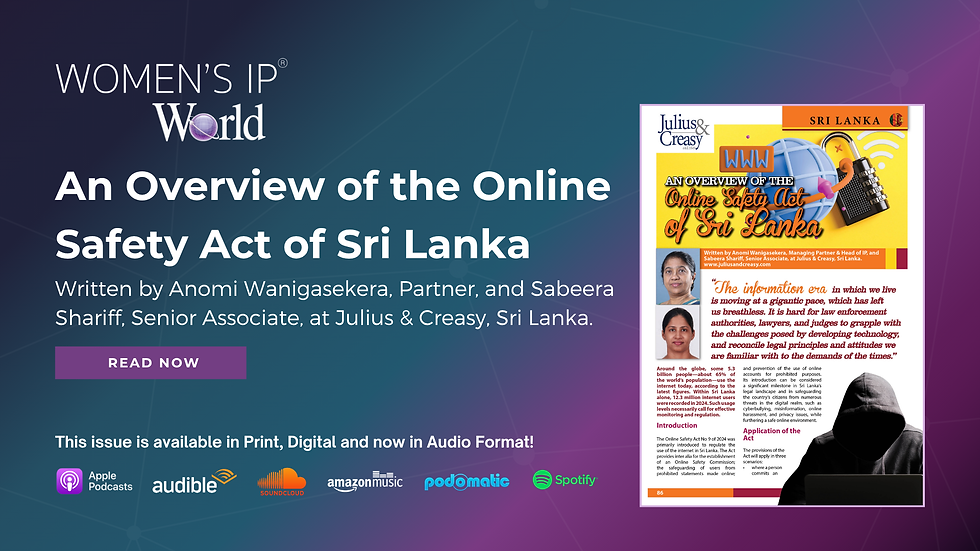An Overview of the Online Safety Act of Sri Lanka by Anomi Wanigasekera and Sabeera Shariff
- Hetanshi Gohil

- 2 days ago
- 2 min read
In the Women’s IP World Annual 2025, Anomi Wanigasekera, Partner, and Sabeera Shariff, Senior Associate, at Julius & Creasy, Sri Lanka, provide an in-depth analysis of the Online Safety Act No. 9 of 2024, a milestone in the nation’s legal framework aimed at safeguarding citizens in the digital space. The Act marks a significant step toward creating a safer, more accountable online environment amid the challenges of misinformation, cyberbullying, and privacy violations.
A Legal Response to a Rapidly Evolving Digital Age
With over 12 million internet users in Sri Lanka and 5.3 billion globally, the digital world is expanding faster than most laws can adapt. The authors note that the Online Safety Act represents an attempt to bridge this gap, modernising the legal response to the realities of social media, online communication, and digital influence.
Objectives of the Online Safety Act
While the Act has faced criticism from human rights groups and journalists for potentially limiting freedom of expression, its primary aim is to protect individuals and institutions from the harmful effects of false or malicious online communication. Key goals include:
Safeguarding individuals from online harassment and false statements.
Protecting the judiciary from contemptuous online comments.
Preserving national security, public order, and social harmony in the digital environment.
The Role of the Online Safety Commission
The Act establishes the Online Safety Commission, a regulatory body empowered to investigate complaints, issue directives to internet service providers, and order the removal of “prohibited statements” from online platforms. It can also disable access to content that threatens public welfare or violates the provisions of the Act.
Defining Prohibited Online Content
Prohibited statements under the Act include:
False or misleading statements threatening national security, public order, or health.
Content that incites hostility between communities or provokes religious or social unrest.
False statements amounting to contempt of court or promoting child abuse, impersonation, or online harassment.
By defining these categories, the law aims to curb digital misuse while preserving legitimate online discourse.
Implementation and Enforcement
Complaints can be filed directly with the Online Safety Commission, which investigates and grants individuals the opportunity to respond. Orders may also be sought through the Magistrates’ Court to prevent further circulation of harmful content. However, the authors caution that balanced enforcement will be essential to prevent misuse or suppression of free expression, especially in politically sensitive contexts.
Conclusion
Sri Lanka’s Online Safety Act marks a vital step toward safer digital spaces. As Anomi Wanigasekera and Sabeera Shariff note, its success will depend on balanced enforcement that protects citizens while upholding freedom of expression.
Read the full article in Women’s IP World Annual 2025, essential reading for legal professionals, policymakers, and digital rights advocates seeking to understand how Sri Lanka is shaping its legal response to online safety in the modern era.






Comments